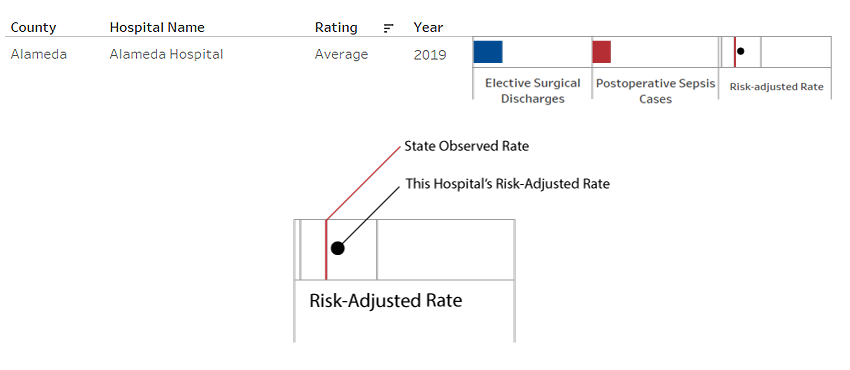California Postoperative Sepsis Outcomes for Inpatient Elective Surgeries
In 2023, 1,038 adult patients developed postoperative sepsis in California hospitals, following an elective surgery. With improvement in care quality, these in-hospital complications may have been avoided.
Why is the Postoperative Sepsis Indicator Important?
The Postoperative Sepsis Indicator, as part of the Patient Safety Indicators (PSIs), is developed by the federal Agency for Healthcare Research and Quality (AHRQ) as a measure of adult patients who developed sepsis in hospital following elective surgeries. This Postoperative Sepsis Indicator, along with the other PSIs, focuses on potentially avoidable in-hospital complications and adverse events that represent opportunities for improvement in the delivery of care. The results provide risk-adjusted hospital rates and performance ratings on postoperative sepsis. Hospitals can utilize the report to improve quality of care and patients can use it to make informed health care decisions.
Which Hospitals Have Above Average and Below Average Postoperative Sepsis Rates?
Hospitals were rated “Above Average,” “Average,” or “Below Average” by comparing their risk-adjusted postoperative sepsis rates with the overall state rates. Risk adjustment is a statistical methodology that takes into account a patient’s age, sex, underlying health conditions, and surgeries the patient has undergone. The majority of hospitals were rated “Average,” indicating their postoperative sepsis rates were not significantly different than the state average. Hospitals with a higher postoperative sepsis rate are distinguished from those with a lower rate, indicating opportunities for health care quality improvement.
Key Findings
- The postoperative sepsis rate for California hospitals in 2023 was 0.48 percent (1,038 cases from 217,922 adult patients undergoing elective surgeries). This is the same rate as last year (1,034 cases from 217,046 elective surgeries).
- In 2023, of the 287 hospitals that were assigned a risk-adjusted rate and performance rating, nine hospitals (3.1 percent) were rated “Above Average,” 15 hospitals (5.2 percent) were rated “Below Average,” and 263 hospitals (91.6 percent) were rated as “Average”.
- In 2022, of the 292 hospitals that were assigned a risk-adjusted rate and performance rating, three hospitals (1.0 percent) were rated “Above Average,” 11 hospitals (3.8 percent) were rated “Below Average,” and 278 hospitals (95.2 percent) were rated as “Average”.
Visualization
The visualization below shows hospitals’ postoperative rates and ratings for 2019 through 2023. The Rating filter allows the user to select a performance category (“Above Average,” “Below Average,” or “Average”) to view the hospitals in that category. Changes have been made to the Agency for Healthcare Research and Quality (AHRQ) software and measure specifications over the past few years; therefore, exact comparisons between years should be interpreted with caution.
Note: Hospitals with fewer than three patients discharged with elective surgeries were excluded from reporting due to the AHRQ methodological requirement.
Understanding the Data
This diagram explains how hospital postoperative rates are depicted in the visualization.

Additional Information
Topic: Healthcare Quality
Source Link: Healthcare Quality – AHRQ Quality Indicators
Citation: HCAI – AHRQ Quality Indicators – Postoperative Sepsis Outcomes for Elective Surgeries in California Hospitals, 2019-2023
Temporal Coverage: 2019-2023
Spatial/Geographic Coverage: Statewide, County
Frequency: Annually

